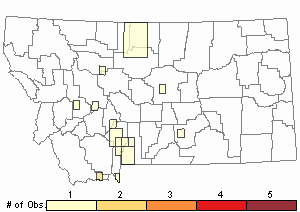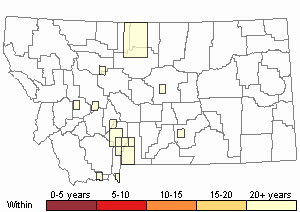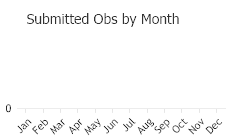View in other NatureServe Network Field Guides
NatureServe
Montana
Utah
Wyoming
Idaho
Wisconsin
British Columbia
South Carolina
Yukon
California
New York
Brunner's Grasshopper - Bruneria brunnea
Other Names:
Bruner Slant-faced Grasshopper,
Stenobothrus brunneus
General Description
The following comes from Hebard (1928), Brooks (1958), Helfer (1971), Otte (1981), Capinera and Sechrist (1982), Vickery and Kevan (1985), McDaniel(1987), Pfadt (2002). A small to medium colorful grasshopper. In lateral view, a vertical white or ivory stripe runs from the base of the antennae to the top of the mandibles. Another ivory or tan stripe runs from the back of the eye and across the pronotum. In dorsal view, a light stripe runs across the central top of the head onto the pronotum, which is cut with one sulcus (groove), constricted near the middle and bears triangular black markings. The hind femur has 3 oblique black stripes on the outer face and the hind tibia is orange or red.
Phenology
Overwinters in the egg stage. Nymphs appear in June but can vary depending upon seasonal variations in snow depth, spring meltdown and elevation and their effects on soil temperatures. Adults occur from June to September (Otte 1984, Pfadt 2002, Scott 2010, and Vickery and Kevan 1985).
Diagnostic Characteristics
The following comes from Hebard (1928), Brooks (1958), Helfer (1971), Otte (1981), Capinera and Sechrist (1982), Vickery and Kevan (1985), McDaniel (1987), and Pfadt (2002). Male body length is 14 mm to 17 mm, and females 18 mm to 23 mm. Forewings (tegmina) are long, reaching to near the tip of the abdomen, with prominent dark spots along the lateral field. The abdominal segments bear black markings. However, the color patterns of this species can be quite variable and may differ from the common pattern described.
This species can be confused with its conger the
Shasta Slant-faced Grasshopper (
Bruneria shastana), and possibly the
Club-horned Grasshopper (
Aeropedellus clavatus), the
Four-spotted Grasshopper (gray-brown form) (
Phlibostroma quadrimaculatum), and the
Brown-spotted Range Grasshopper (
Psoloessa delicatula). Refer to these species to compare diagnostic characteristics. Note: Some Orthoptera texts, field guides, and literature classify this species as
Stenobothrus brunneus (Capinera and Sechrist 1982, Otte 1981, and Scott 2010).
Species Range
Montana Range
Range Descriptions

 Native
Native
Range Comments
The Brunner's Grasshopper ranges from British Columbia, Alberta, Saskatchewan, southward to northern Arizona. Also from Montana, southeast Idaho, Utah, eastward to the Dakotas, west Nebraska and Colorado. In Montana it has been reported for 25 counties (Otte 1984, Pfadt 2002, Scott 2010, and Vickery and Kevan 1985).
Observations in Montana Natural Heritage Program Database
Number of Observations: 16
(Click on the following maps and charts to see full sized version)
Map Help and Descriptions
Relative Density

Recency


 (Observations spanning multiple months or years are excluded from time charts)
(Observations spanning multiple months or years are excluded from time charts)
Habitat
Inhabits mixedgrass and bunchgrass prairies, mountain meadows, parklands, and alpine tundra at altitudes ranging from 1,600 to 11,100 feet (Pfadt 2002).
Food Habits
This species is a grass and sedge feeder, but its precise diet depends upon which host plants are available in its widespread habitat. Among favored foods include
blue gramma (
Bouteloua gracilis),
side-oats grama (
Bouteloua curtipendula),
crested wheatgrass (
Agropyron cristatum), needlegrass,
prairie junegrass (
Koeleria macrantha),
needle-and-thread (
Stipa comata),
Carex sedges and a host more.
Reproductive Characteristics
Scant information is available regarding courtship, mating and oviposition for this species. One study however, indicates that oviposition begins about 18 days after the appearance of the adults and continues into late September. There are 2 to 10 eggs per pod with an average of six. Seasonal temperatures greatly influence time of egg laying. The hatching period is short, lasting about 2 weeks. Nymphs pass through 4 instars before reaching the adult stage. Some field observations indicate that this species may have a two-year life cycle in mountain meadow and northern grassland habitats (Pfadt 2002).
Stewardship Responsibility
References
- Literature Cited AboveLegend:
 View Online Publication
View Online Publication Brooks, A.R. 1958. Acridoidea of Southern Alberta, Saskatchewan, and Manitoba (Orthoptera). The Canadian Entomologist (Supplement 9) 90:5-92.
Brooks, A.R. 1958. Acridoidea of Southern Alberta, Saskatchewan, and Manitoba (Orthoptera). The Canadian Entomologist (Supplement 9) 90:5-92. Capinera, J.L. and T.S. Sechrist. 1982. Grasshoppers of Colorado: Identification, Biology, and Management. Fort Collins, CO: Colorado State University Experiment Station, Bulletin 584S. 161 p.
Capinera, J.L. and T.S. Sechrist. 1982. Grasshoppers of Colorado: Identification, Biology, and Management. Fort Collins, CO: Colorado State University Experiment Station, Bulletin 584S. 161 p. Hebard, M. 1928. The Orthoptera of Montana. Proceedings of the Academy of Natural Sciences of Philadelphia, Vol. 80:211-306.
Hebard, M. 1928. The Orthoptera of Montana. Proceedings of the Academy of Natural Sciences of Philadelphia, Vol. 80:211-306. Helfer, J.R. 1971. How to Know the Grasshoppers, Crickets, Cockroaches, and Their Allies. Revised edition (out of print), Mineola, NY: Dover Publications.
Helfer, J.R. 1971. How to Know the Grasshoppers, Crickets, Cockroaches, and Their Allies. Revised edition (out of print), Mineola, NY: Dover Publications. McDaniel, B. 1987. Grasshoppers of South Dakota. Brookings, SD: South Dakota Agricultural Experiment Station, Bulletin TB 89.
McDaniel, B. 1987. Grasshoppers of South Dakota. Brookings, SD: South Dakota Agricultural Experiment Station, Bulletin TB 89. Otte, Daniel. 1981. The North American Grasshoppers. Volume 1. Acrididae (Gomphocerinae and Acridinae). Harvard University Press. 275 pp.
Otte, Daniel. 1981. The North American Grasshoppers. Volume 1. Acrididae (Gomphocerinae and Acridinae). Harvard University Press. 275 pp. Pfadt, R.E. 2002. Field Guide to Common Western Grasshoppers, 3rd edition. Laramie, WY: Wyoming Agricultural Experiment Station, Bulletin 912, modified by S. Schell and S. Schell for electronic publication. Accessed 19 February 2020. http://www.uwyo.edu/entomology/grasshoppers/field-guide/index.html#fieldguidetoc
Pfadt, R.E. 2002. Field Guide to Common Western Grasshoppers, 3rd edition. Laramie, WY: Wyoming Agricultural Experiment Station, Bulletin 912, modified by S. Schell and S. Schell for electronic publication. Accessed 19 February 2020. http://www.uwyo.edu/entomology/grasshoppers/field-guide/index.html#fieldguidetoc Scott, R.D. 2010. Montana Grasshoppers, Katydids, and Crickets A Pictorial Field Guide to the Orthoptera. MagpieMTGraphics, Billings, MT.
Scott, R.D. 2010. Montana Grasshoppers, Katydids, and Crickets A Pictorial Field Guide to the Orthoptera. MagpieMTGraphics, Billings, MT. Vickery, V. R. and D. K. M. Kevan. 1985. The grasshopper, crickets, and related insects of Canada and adjacent regions. Biosystematics Research Institute, Ottawa, Ontario. Publication Number 1777. 918 pp.
Vickery, V. R. and D. K. M. Kevan. 1985. The grasshopper, crickets, and related insects of Canada and adjacent regions. Biosystematics Research Institute, Ottawa, Ontario. Publication Number 1777. 918 pp.
- Additional ReferencesLegend:
 View Online Publication
View Online Publication
Do you know of a citation we're missing? Anderson, N.L. 1962. Grasshopper-vegetation relationships on Montana grasslands. Ph.D Dissertation. Bozeman, Montana: Montana State University. 73 p.
Anderson, N.L. 1962. Grasshopper-vegetation relationships on Montana grasslands. Ph.D Dissertation. Bozeman, Montana: Montana State University. 73 p. Capinera, J.L., R.D. Scott, and T.J. Walker. 2004. Field Guide to Grasshoppers, Katydids, and Crickets of the United States. Ithaca, NY. Cornell University Press.
Capinera, J.L., R.D. Scott, and T.J. Walker. 2004. Field Guide to Grasshoppers, Katydids, and Crickets of the United States. Ithaca, NY. Cornell University Press. Henry, J.E. 1969. Protozoan and viral pathogens of grasshoppers. Ph.D. Dissertation. Bozeman, MT: Montana State University. 153 p.
Henry, J.E. 1969. Protozoan and viral pathogens of grasshoppers. Ph.D. Dissertation. Bozeman, MT: Montana State University. 153 p. Skinner, K.F. 1995. Plant and grasshopper community composition: indicators & interactions across three spatial scales. M.Sc. Thesis. Bozeman, MT: Montana State University. 144 p.
Skinner, K.F. 1995. Plant and grasshopper community composition: indicators & interactions across three spatial scales. M.Sc. Thesis. Bozeman, MT: Montana State University. 144 p.
- Web Search Engines for Articles on "Brunner's Grasshopper"
- Additional Sources of Information Related to "Insects"





